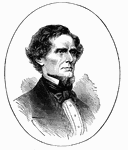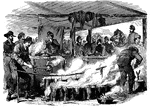
Cooking in Camp
The kitchen of the Fremont Dragoons at Tipton, Missouri. Tipton, which is 38 miles from Jefferson City,…

Camp Lillie
Headquarters of General Freemont, Jefferson City, Missouri, October 1, 1861. Jefferson City is on the…

United States Arsenal at Charleston
At the time this picture was drawn the handsome arsenal of the government of Charleston, South Carolina,…

Company H
"Successful charge of Company H, first Massachusetts regiment (Captain Carruth), on a Confederate redan…
Rappahannock
"The city of Fredericksburg, VA., from the North side of the Rappahannock- from a sketch by our special…
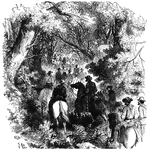
Laurel Hill
"Advance of General Rosecrans's division through the forests of Laurel Hill to attack the Confederate…
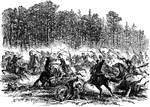
Sixth Regiment
"Gallant charge of the Sixth Regiment, United States Regular Cavalry, upon the Confederate Stuart's…

General Rosecrans
"General Rosecrans, commanding the Department of Western Virginia, surrounded by his staff, at their…

Manassasas Junction
"Manassasas Junction, showing the evacuated Confederate fortifications, abondoned camps and wagons,…

Battle of Cross Keys
"The Battle of Cross Keys- opening of the fight- the federal troops, under General Fremont, advancing…

Shenandoah Valley
"The army of General Fremont on its march up the Shenandoah Valley- wounded and ragged soldiers. Fremont…
!["[African American] drivers of the baggage train attached to General Pleasonton's Cavalry brigade watering their mules in the Rappahannock. General Pleasonton's cavalry was attended by a very efficient forage brigade, consisting of mules and [African American] riders. Our sketch represents their drivers taking them to water at the river. The hard work these animals will endure is something wonderful, and justifies the high estimation in which they are held in the army." — Frank Leslie, 1896](https://etc.usf.edu/clipart/11000/11025/baggagetrain_11025_mth.gif)
Baggage Train
"[African American] drivers of the baggage train attached to General Pleasonton's Cavalry brigade watering…
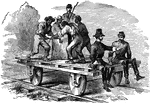
General Burnside
"Traveling in state"- General Burnside on the road from New Berne to Beaufort, N. C.
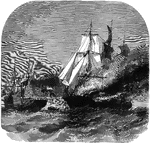
Harvey Birch
"Burning of the American merchantman "Harvey Birch," of New York, Captain Nelson, in the British Channel,…

Gunboat collision
"Desperate engagement, april 24th, 1862, between the United States gunboat "Varuna," Commander Boggs,…
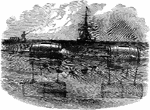
Infernal machine
"Infernal machine designed by the Confederates to destroy the Federal Flotilla in the Potomac discovered…
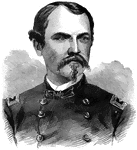
General W. W. Averill
"General Averill, born in Cameron, Steuben County, N. Y., November 5th, 1832, was graduated at the United…
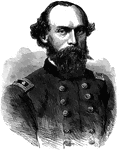
General Gordon Granger
"General Granger, born in New York, in 1821, died in Santa Fe, N. M., January 10th, 1876, was graduated…
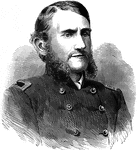
General Judson Kilpatrick
"General Kilpatrick, born near Deckertown, N. J., January 14th, 1836, died in Valparaiso, Chili, December…
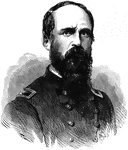
Colonel E. E. Cross
"Colonel Cross, born in Lancaster, N. H., April 22nd, 1832, died near Gettysburg, Pa., July 22nd, 1863.…

Old Church
"Desperate skirmish at Old Church, near Tunstall's Station, VA., between a squadron of the Fifth United…
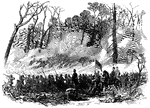
Battle of Shiloh
"Battle of Shiloh, or Pittsburg Landing, left wing- the woods on fire during the engagement of Sunday,…

Westfield
"Fire raft sent down from Fort Jackson to destroy the Federal fleet below the fort- the boats of the…

Massachusetts Battery
Martin's Massachusetts Battery C opening fire on the Confederate fortifications commanding the approaches…
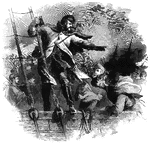
Burnside Expedition
"Burnside Expedition- the fleet and transports off Hatteras during the storm- the general giving orders.…

Federal Kitchen
"The Federal Kitchen on the march to Fredericksburg with three days' rations." — Frank Leslie,…
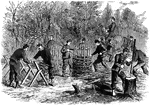
77th Pennsylvania Regiment
"Captain Muller's Battery Company of the Seventy-seventh Pennsylvania Regiment making fascines and gabions…

Captain Knapp
"Captain Knapp's Battery engaging the Confederates at the battle of Cedar Mountain, August 9th, 1862-…
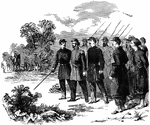
Major Taylor
"Escorting Major Taylor, of New Orleans, the bearer of a flag of truce, blindfolded, to the Confederate…
!["First and last review of the First Regiment, South Carolina [African American] Volunteers, on Hilton Head, S. C., under Colonel Fessenden, U. S. A., June 25th, 1862. Our correspondent at Hilton Head wrote us: "I witnessed the parade entire, as well as the company drills in the manual of arms, etc., afterward, and I must acknowledge my complete surprise at the discipline and even vim evinced by the sable crowd. Dressed in the regulation uniform of the United States Army, tall and strong men generally speaking, they, considering that the regiment had not been fully armed but about ten days, spoke well for officers and men."" — Frank Leslie, 1896](https://etc.usf.edu/clipart/11000/11043/1stregiment_11043_mth.gif)
First Regiment
"First and last review of the First Regiment, South Carolina [African American] Volunteers, on Hilton…

Battle of Cedar Mountain
"Gordon's and Crawford's Brigades driving the Confederate forces from the woods at the Battle of Cedar…
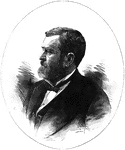
Ulysses Grant
General Grant, eighteenth President of the United States, born at Point Pleasant, Clermont County, Ohio,…
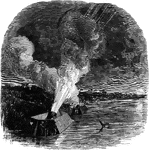
Siege of Island
"Siege of Island No. 10, on the Mississippi River- night bombardment by the Federal mortar boats, ten…

Great Bakery
"The Great Bakery for the United States Army at the Capitol, Washington, D. C.- sketched by our special…
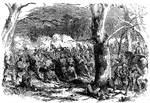
Storming of Fort Donelson
"Storming of Fort Donelson- decisive bayonet charge of the Iowa Second Regiment on the Confederate intrenchments…

Great Falls
"Shelling Confederate cavalry across the Potomac River from the heights of Great Falls, by Major West,…

Munson's Hill
"Skirmishing between the pickets of the two armies near Munson's Hill- the hill in the distance. Munson's…

Craney Island
"Blowing up the Confederate forts on Craney Island, by Commodore Goldsborough, June 2nd 1862." —…

Bombardment of Island No. 10
"Bombardment of Island No. 10 and the fortifications opposite, on the Kentucky Shore, by the Federal…

Battle of Cedar Mountain
"The Confederate batteries shelling the Federal position on the night of the Battle of Cedar Mountain,…

Battle of Winchester
"Battle of Winchester, VA., March 23rd, 1862- decisive bayonet charge of the Federal troops, led by…
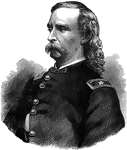
George Custer
"General George A. Custer, born in New Rumley, Harrison County, Ohio, December 5th, 1839, died in Montana,…
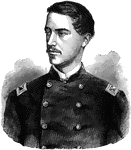
Ulric Dahlgren
"Colonel Ulric Dahlgren, born in Bucks County, Pa., in 1842, died near King and Queen's Courthouse,…
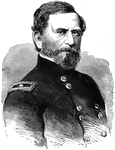
J. T. Sprague
"General J. T. Sprague, born in Newburyport, Mass., July 3rd, 1810, died in New York city, September…
!["General Lorenzo Thomas, born in Newcastle, Del., October 26th, 1804, died in Washington, D. C., March 2nd, 1875, was graduated from the United States Military Academy in 1823; served in the Florida and Mexican Wars, and received the brevet of lieutenant colonel for gallantry at Monterey. On the 7th of May, 1861, he was brevetted brigadier general, and made adjutant general of the army on August 3rd, with the full rank of brigadier general. He served until 1863, when he was intrusted for two years with the organization of [African American] troops in the Southern States. He was brevetted major general, United States Army, on March 13th, 1865. He was retired in 1869." — Frank Leslie, 1896](https://etc.usf.edu/clipart/11000/11059/thomas_11059_mth.gif)
Lorenzo Thomas
"General Lorenzo Thomas, born in Newcastle, Del., October 26th, 1804, died in Washington, D. C., March…
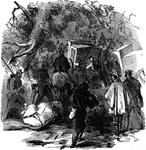
March of General Banks
"Incident in the march of General Banks's Division during a storm in Western Maryland." — Frank Leslie,…
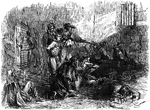
Prison
"The humors of a prison- scene in a station-house cell, Washington, D. C., after the appointment of…

Attack at Harrisonburg
"Gallant attack by 150 of the Pennsylvania Bucktails, led by Colonel Kane, upon a portion of General…

Pontoon bridge
"General Fremont's Division crossing the Pontoon Bridge over the Shenandoah River in pursuit of the…

Adams Express
"Scene in Adams Express office, at Fortress Monroe, VA., in 1861- Volunteers receiving letters and packages…
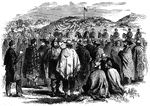
Confederate Prisoners
"Group of Confederate prisoners captured at Fort Donelson, on the morning after the surrender, clothed…
New Jersey Troops
"The New Jersey troops crossing the Chesapeake Bay, in sixteen propellers, on their way to Washington,…

First naval battle
"First naval battle in Hampton Roads between the Confederate iron-plated steamers Merrimac, Yorktown,…

Second Naval Battle
"Second naval battle in Hampton Roads- fight between the Federal ironclad Monitor, of two guns,…

Fort Hatteras
"General view of Forts Hatters and Clark, N. C., captured on the 29th of August, 1861, by the Federal…
